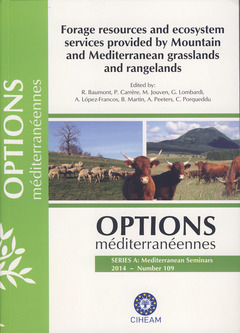Description
Forage resources and ecosystem service provided by Mountain and Mediterranean grasslands and rangelands
Options méditerranéennes SERIES A : Mediterranean seminars Series, Vol. 109
Authors: BAUMONT R., CARRÈRE P., JOUVEN M., LOMBARDI G., LOPEZ-FRANCOS A., MARTIN B., PEETERS A., PORQUEDDU C.
Language: English
Subjects for Forage resources and ecosystem service provided by...:
Approximative price 106.71 €
In Print (Delivery period: 10 days).
Add to cart
Publication date: 06-2014
843 p. · 17x24 cm · Paperback ·
843 p. · 17x24 cm · Paperback ·
Description
/li>
In constrained environments such as mountainous and Mediterranean areas
the sustainable use of forage resources by domestic herbivores has to
combine production, conservation of high environmental value areas and
product quality. The sustainability of animal production systems relies on
their ability to reconcile economic performance based on the added value
of high quality animal products and ecological performance based on the
implementation of management practices relying on agro-ecological
principles and allowing compensatory payments for the production of public
goods. This publication is the outcome of a joint meeting of the "Mountain
Pastures, Mediterranean Forage Resources (FAO/ESCORENA - CIHEAM) and
Mountain Cheese" networks entitled "Forage resources and ecosystem
services provided by mountain and Mediterranean grasslands and rangelands"
which was organized in Clermont-Ferrand (France) from 24 to 26 June 2014.
This multidisciplinary meeting aimed at sharing/contrasting viewpoints,
methods and results of specialised scientists working on grassland and
rangeland assessment and use. In a context of climate change and
environmental concerns, livestock farming systems in Mediterranean and
mountain areas share issues common to harsh environments, which can be
dealt with by using similar theoretical and methodological frameworks.
Cultivated or spontaneous vegetation, herbaceous or ligneous species, all
forage resources should be considered together, as complementary items
contributing to the multiple performances of livestock systems. More than
140 scientific contributions were presented and discussed including
introductory and invited papers, short oral communications and posters.
The contributions were presented by specialists from 22 different
countries of mountain and mediterranean climate areas all over the world
(Europe, Africa, South-America, Oceania and Asia).
© 2024 LAVOISIER S.A.S.

